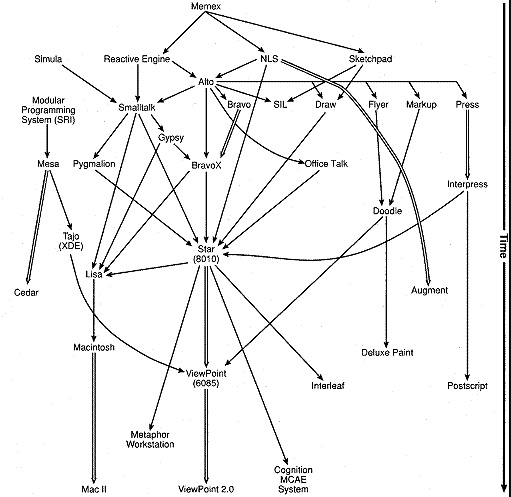Excerpts from The Xerox "Star": A Retrospective
by:
Jeff Johnson and Teresa L. Roberts, U S WEST Advanced Technologies
William Verplank, IDTwo
David C. Smith, Cognition, Inc.
Charles Irby and Marian Beard, Metaphor Computer Systems
Kevin Mackey, Xerox Corporation
See http://www.geocities.com/SiliconValley/Office/7101/retrospect/index.html
The Reactive Engine
While Engelbart et al were developing ideas, some of which eventually found
their way into Star, Alan Kay, then a graduate student, was doing likewise.
His dissertation, The Reactive Engine, contained seeds of many ideas that
he and others later brought to fruition in the Smalltalk language and programming
environment, which, in turn, influenced Star. Like the designers of NLS,
Kay realized that interactive applications do not have to treat the display
as a "glass teletype" and can share the screen with other programs.
Smalltalk
Alan Kay had been one of the main advocates of the Alto. His Learning Research
Group (LRG) began using the Alto to build prototypes for a personal computing
system "of the future": a portable machine that would provide -- rather
than a canned set of applications -- the building blocks necessary for
users to build the tools and applications they need to solve their own
information processing problems. The technologies needed to build a lap
computer with the power of the "DynaBook" (as the envisioned system was
called) were unavailable at the time, and still are. The prototypes developed
by Kay's group evolved into the Smalltalk language and programming environment.
They further promoted the notion of personal computing, pioneered complete,
interactive programming environments, and refined and solidified concepts
of object-oriented programming that had been extant only in vestigial form
in previous systems. Most importantly for Star, they demonstrated the power
of graphical, bitmapped displays, mouse-driven input, windows, and simultaneous
applications. This is the most visible link between Smalltalk and Star,
and is perhaps why many people wrongly believe that Star was written in
Smalltalk.
Pygmalion
The first large program to be written in Smalltalk was Pygmalion, the doctoral
thesis project of David Smith. One goal of Pygmalion was to show that programming
a computer does not have to be primarily a textual activity: it can be
accomplished, given the appropriate system, by interacting with graphical
elements on a screen. A second goal was to show that computers can be programmed
in the language of the user interface, i.e., by demonstrating what one
wants done and having the computer remember and reproduce it. The idea
of using icons -- images that allow users to manipulate them and in so
doing act upon the data they represent -- came mainly from Pygmalion. After
completing Pygmalion, Smith worked briefly on the NLS project at SRI before
joining the Star development team at Xerox.
Influence of systems

Conclusions
Star has had an indisputable influence on the design of computer systems.
For example, the Lisa and Macintosh might have been very different had
Apple's designers not borrowed ideas from Star, as the following excerpt
of a Byte magazine interview of Lisa's designers shows:
Byte: Do you have a Xerox Star here that you work with?
Telser: No, we didn't have one here. We went to the NCC when the Star
was announced and looked at it. And in fact it did have an immediate impact.
A few months after looking at it we made some changes to our user interface
based on ideas that we got from it. For example, the desktop manager we
had before was completely different; it didn't use icons at all, and we
never liked it very much. We decided to change ours to the icon base. That
was probably the only thing we got from Star, I think. Most of our Xerox
inspiration was Smalltalk rather than Star.
Elements of the Desktop metaphor approach can also be seen in many other
systems.
The history presented here has shown, however, that Star's designers
did not invent the system out of nothingness. Just as it has influenced
systems that came after it, Star was influenced by ideas and systems that
came before it. It is difficult to inhibit the spread of good ideas once
they are apparent to all, especially in this industry. Star was thus just
one step -- albeit an important one -- in an evolutionary process that
will continue both at Xerox and elsewhere. That is how it should be.

